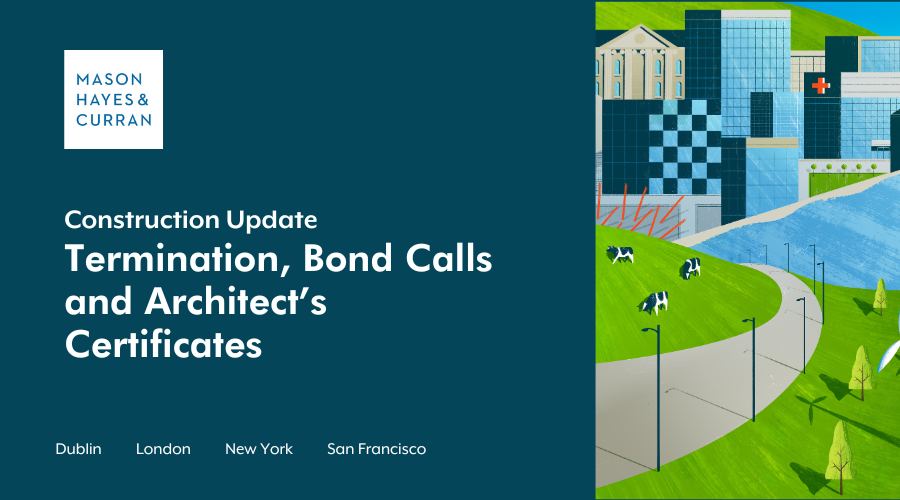
Our Construction, Infrastructure & Utilities team examines a recent Commercial Court judgment dealing with termination under the RIAI Form of Contract and the contractual requirements for a making a subsequent call on a performance bond.
MHC (Rory Kirrane SC and Hannah Devoy) represented the successful bondsman at hearing before the Commercial Court[1]. The judgment delivered touches on significant and topical construction law issues relating to the RIAI Form of Contract and Public Works Model Form of Performance Bond.
Gembira (the Employer) entered into a bespoke contract based on the RIAI form with MDY Construction (the Contractor) for the construction of a residential development in Dublin (the Contract).
AmTrust (the Surety) issued a performance bond modelled on the public works form (the Bond).
Clause 1 of the Bond provided that if the Employer terminated the Contractor’s employment, the Surety would pay the Employer the amount for which the Contractor was liable under Clause 33 of the Contract. Clause 33 dealt with the financial consequences of termination. It required the architect to verify the completion accounts and to certify the expenses incurred by the Employer in completing the works.
The Contractor entered examinership and the Employer terminated its employment. The Employer called on the Bond and ultimately issued proceedings against the Surety seeking summary judgment.
The High Court dismissed the Employer’s application. In a judgment reinforcing the importance of precise compliance with contractual requirements, the Court found in favour of the Surety on a number of grounds:
- The Bond was a conditional guarantee not an on-demand instrument. The Court rejected the Employer’s argument that the Surety could not look behind the architect’s certificate. The Court agreed with the Surety that the Employer must instead demonstrate the debt due by the Contractor.
- Clause 33(c)(iv) requires the architect to verify the completion accounts and to certify the expenses incurred by the Employer. The Court accepted the Surety’s submission that this had not occurred because the Employer’s claim was based on estimated rather than verified completion accounts.
- Examining the architect’s certificate, the Court applied Token Construction v Charlton Estates[2] and the three-fold test of whether a document is “in form, in substance or intent” the certificate prescribed by the Contract. The architect’s certificate did not comply with the contractual requirements and was not an effective certificate within the meaning of Clause 33.
Adding to an emerging body of case law on the question of whether there is a direct right of action against a Surety, the High Court found that the Employer did not have to bring a claim in arbitration against the Contractor before calling on the Bond. This finding however did not relieve the Employer of its obligation to establish the debt due by the Contractor in accordance with requirements of Clause 33(c)(iv).
Conclusion
This case deals with important issues that commonly arise under the RIAI Form of Contract and Public Works Model Form of Bond which have generated only a very limited number of written decisions.
The judgment will be of interest to those putting in place, relying on, or issuing performance security, and is notable for its clear emphasis on the importance of careful compliance with contractual requirements.
For more information, contact a member of our Construction, Infrastructure & Utilities team.
The content of this article is provided for information purposes only and does not constitute legal or other advice.
[1] Gembira Limited v AmTrust Europe Limited [2024] IEHC 188
[2] (1973) 1 BLR 48
Share this:

Rory Kirrane SC
Partner, Head of Construction, Infrastructure and Utilities
+353 86 171 6616 rkirrane@mhc.ie

